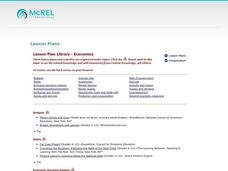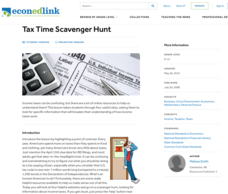Council for Economic Education
Opportunity Cost
The price of those new shoes involves more than just money! Individuals explore the concept of opportunity cost using a video clip and gratification discussions. They prepare a budget based off of their set of values in regards to...
Curated OER
Invest In Yourself
Students learn about budgeting, saving, dept, financial management, opportunity cost, and self-regulation. For this financial management lesson, students apply their knowledge of finance components and create their own web based plan...
Curated OER
Scarcity, Choice and Decisions
Students study the basic economic trilogy (scarcity, choice, and costs). For this money management lesson, students use a scenario of a High School Prom to calculate how scarcity, choice and cost apply by completing provided worksheets...
Curated OER
Micro Economics - Personal Budgeting
Students explore the real world as it relates to money and how people use it. In this money management lesson, students jump into the real world as they role play with money through spending, saving, being married, single, having...
Curated OER
The Consumer Price Index: A Measure of Inflation
Students examine inflation over the years and learn to calculate how it changes over time. In this money management lesson plan, students learn how price changes affect their purchasing power, how to come up with strategies for dealing...
Curated OER
Reading the Financial Pages: In Print and Online
Students study information presented in the financial pages of newspapers and online sources They learn how to follow stocks online.
PBS
Could You Start a Business?
High schoolers learn how a business starts and finds financial independence. For this lesson, students learn the struggle of financial management, the costs of running a business and how to keep a budget.
Curated OER
FINANCE AND RESPONSIBLE LENDING.
Learners study the role of banks, lending and their services. In this analysis lesson, students learn about savings, checking accounts and lending and the importance of banks as financial intermediaries.
Curated OER
"The Leaves in October", by Karen Ackerman
Pupils read a story about a family living in a shelter. They explore different places to save their money and the advantages and disadvantages of each.
Curated OER
"Four Dollars and Fifty Cents," by Eric Kimmel
Students use the book, "Four Dollars and Fifty Cents" to discover ways that creditors can obtain payment from reluctant debtors
Practical Money Skills
Making Decisions
A set of quizzes and assessments would make a great companion to your lesson on making decisions and opportunity risks. Learners watch a PowerPoint before answering multiple choice questions about interest rates, saving money, and the...
Texas Education Agency (TEA)
Creating a Lifestyle Budget
Using the practical resource, pupils view a PowerPoint and complete a KWL chart to learn all about budgeting. To finish, they create a budget based on their projected lifestyle profiles.
Nebraska Department of Education
Time Management
As eighth-graders move on to high school, strong time management skills become critical. As part of a career Planning & Management unit, scholars learn how to analyze their time and consider how their choices impact their ability to...
Federal Reserve Bank
The Fed - Helping Keep Banks Safe and Sound
What does an examiner look for when analyzing a bank's financial condition? In addition to learning about the 5-Cs for reviewing loans and CAMELS (capital, assets, management, earnings, liquidity, and sensitivity to risk), your learners...
Texas Education Agency (TEA)
Identity Theft and Credit Safety
Deter, detect, defect. Pupils watch a PowerPoint presentation and video about identity theft and credit card safety, taking notes to use later. Next, they develop a plan for maintaining credit safety and write an essay about the topic.
California Department of Education
California CareerZone Make Money Choices Student Workbook
An activity challenges scholars to make smart money choices. While visiting the California CareerZone website, pupils choose between budgeting for one's lifestyle or salary and complete a two-page worksheet based on the information...
Nebraska Department of Education
How Do You Define “Friend?”
Shared values are often the keystone in friendships. Class pairs use their "Values" handout from a previous instructional activity and interview one another to identify values they share and don't share. Then, consider how their...
Council for Economic Education
Tax Time Scavenger Hunt
Is a 1040EZ tax form really easy? Scholars investigate the complexities of the United States taxation system with an economics lesson. Using a wide variety of web sources, they interpret IRS taxation rules and regulations to better...
Council for Economic Education
Sand Art Brownies
Which is better, Coke or Pepsi? Pupils analyze the concept of substitute goods as they investigate the choice to purchase alternate products for better prices. Fun and practical, the engaging shopping exercise helps savvy scholars get...
Council for Economic Education
A Penny Saved
A penny saved is a penny earned! Scholars research the different ways to save money over a lifetime. They investigate the Rule of 72, compound interest, and sub-prime loans to gain an understanding of how banks aid in the saving process....
Practical Money Skills
Using Banking Services
Using a bank is a privilege and a responsibility for young consumers. Teach them the important terms and details about creating accounts, using an ATM, and maintaining a credit card.
Practical Money Skills
Protecting Your Money
How can you tell if a commercial or salesperson is being misleading? Encourage your learners to protect themselves and their money with a lesson about consumer rights. They review laws that keep consumers safe from faulty claims and...
EngageNY
Buying a Car
Future car owners use geometric sums to calculate payments for a car loan in the 31st installment of a 35-part module. These same concepts provide the basis for calculating annuity payments.
EngageNY
Buying a House
There's no place like home. Future home owners investigate the cost of buying a house in the 33rd installment of a 35-part module. They come to realize that the calculations are simply a variation of previous formulas involving car loans...

























